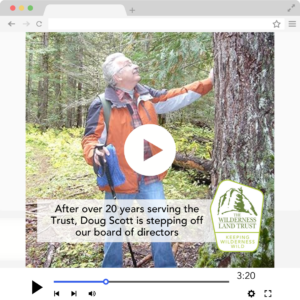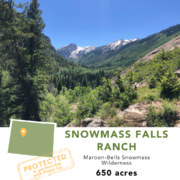Saying thank you & farewell to wilderness legend Doug Scott

May 17, 2024-
Doug began his work in wilderness conservation just 4 years after passage of the 1964 Wilderness Act, and in the years since has helped establish and expand America’s wilderness areas and grow the wilderness community.
Doug’s fellow board members and staff shared just a few of the many ways Doug’s leadership and expert knowledge has helped The Trust over the years in this short video.
Doug holds a forestry degree from the University of Michigan, where he did his graduate research on the history and drafting of what became the Wilderness Act of 1964. Doug began his own work for wilderness preservation soon after the Wilderness Act became law. As a volunteer activist while in graduate school, a Washington lobbyist for The Wilderness Society, and northwest representative for the Sierra Club, he was in the forefront of many of the important wilderness preservation campaigns as a strategist and lobbyist, including: The Eastern Wilderness Areas Act (1975), the Endangered American Wilderness Act (1978), the Frank Church-River of No Return Wilderness (1980), the Alaska National Interest Lands Conservation Act (1980) and the California Desert Protection Act (1994) among many other wilderness designation statutes. In the 1980s, Doug was conservation director and, later, associate executive director of the Sierra Club, and in 1996 he received the club’s highest honor, the John Muir Award.
In addition to the many direct contributions Doug has had growing our national wilderness, he is also one of the leading wilderness historians. He is the author of The Enduring Wilderness: Protecting our Natural Heritage through the Wilderness Act and Our Wilderness: America’s Common Ground.
As much as we hate to lose Doug from our board of directors, we look forward to many more years of friendship with Doug! So it’s not ‘goodbye’ it’s ‘see you soon’.
Get more wilderness news delivered to your inbox!
By submitting this form, you are consenting to receive marketing emails from: Wilderness Land Trust. You can revoke your consent to receive emails at any time by using the SafeUnsubscribe® link, found at the bottom of every email. Emails are serviced by Constant Contact












 out much of Colorado’s high country, including deep in what today is designated wilderness, traces of mining history can be found, from mine shafts still framed in timbers to bits of rusted machinery and bean cans. The majority of these silver, gold, and copper mines were small-scale, and the landscapes around them have recovered quickly, wiping away most traces of their camps and wagon trails. These small operations were certainly much different than the kinds of mega-mines we see today, removing entire mountain tops and reshaping vast landscapes to access ore. But they still serve as a reminder of what could have been. Had the boom not turned to bust so quickly, or had the lasting protections of designated wilderness not been established 60 years ago, the basins and ridges of Colorado’s high country might have looked much different today, including those surrounding the Copper Glance Lode property.
out much of Colorado’s high country, including deep in what today is designated wilderness, traces of mining history can be found, from mine shafts still framed in timbers to bits of rusted machinery and bean cans. The majority of these silver, gold, and copper mines were small-scale, and the landscapes around them have recovered quickly, wiping away most traces of their camps and wagon trails. These small operations were certainly much different than the kinds of mega-mines we see today, removing entire mountain tops and reshaping vast landscapes to access ore. But they still serve as a reminder of what could have been. Had the boom not turned to bust so quickly, or had the lasting protections of designated wilderness not been established 60 years ago, the basins and ridges of Colorado’s high country might have looked much different today, including those surrounding the Copper Glance Lode property.





